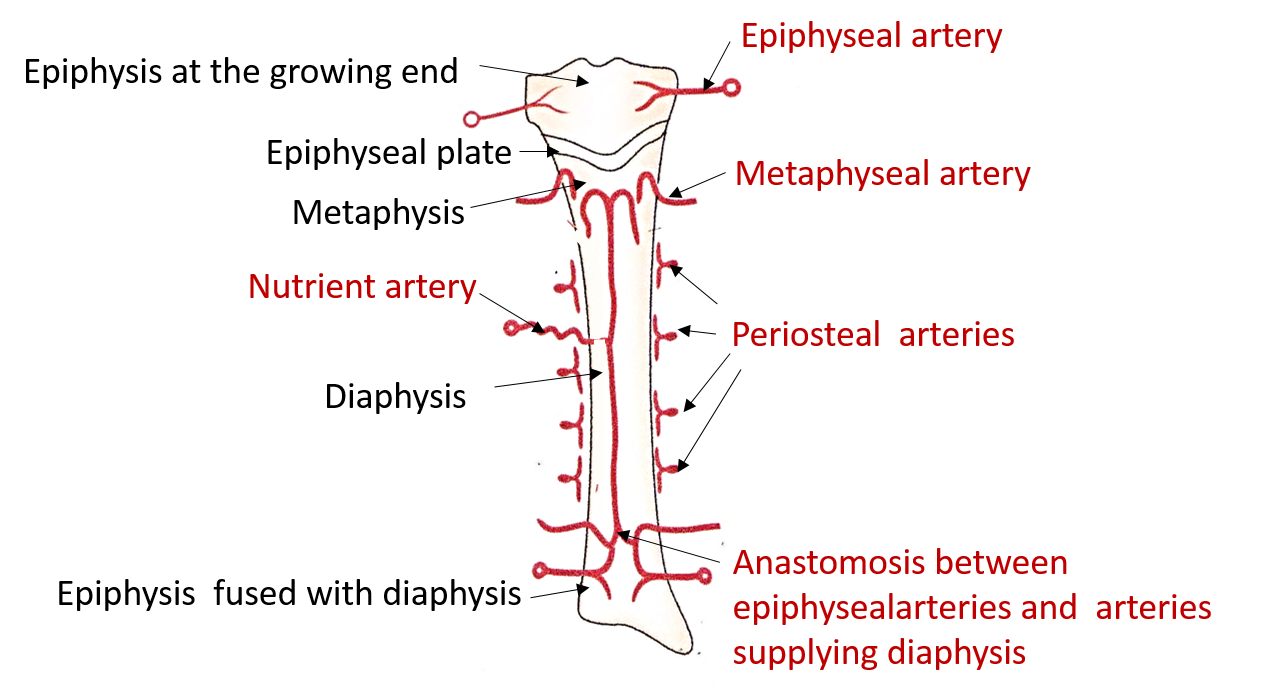What are the Parts of an Adult Long Bone?
Parts of an adult long bone: Adult long bone has two ends and an intervening shaft.
• Shaft (diaphysis)The shaft of the long bone is composed of the following from outside to inside
• Periosteum: It is a thick fibro-cellular layer that covers the outer surface of bone except the articular surfaces which are covered by articular cartilage (hyaline cartilage). It has two layers:
- Outer fibrous layer
- Inner cellular layer or osteogenic layer (containing osteoprogenitor cells which form osteoblasts).
- It is united to the underlying bone by Sharpey’s fibers (collagen fibers).
- It has very rich nerve supply and therefore it is the most pain sensitive part of bone.
• Cortex (cortical bone): It is made up of dense compact/cortical bone.
• Marrow cavity: deep to the cortex is the medullary cavity. It is lined by endosteum and is filled with bone marrow (depending upon age of the individual it can be red or yellow marrow).
• Ends of long bone (Epiphysis): Are made up of cancellous bone (having bony trabeculae and marrow spaces (filled with red bone marrow)). The articular surfaces at the ends are covered by articular (hyaline) cartilage).

Describe the Arterial Supply of Developing Long bone.
Developing long bone is supplied by the following arteries:
• Nutrient artery:
o It enters the shaft through the nutrient foramen.
o Runs obliquely through the cortex of shaft.
o Reaches medullary cavity and divides into ascending and descending branches.
o These branches reach the metaphysis and form ‘hair pin loops’ and anastomose with the metaphyseal and epiphyseal arteries.
o The nutrient artery supplies the
medullary cavity
inner 2/3rd of cortical bone of diaphysis
metaphysis
• Periosteal arteries:
o Are branches of neighbouring muscular arteries and therefore they are especially numerous beneath the muscular attachments.
o They ramify beneath the periosteum and reach the underlying cortical bone through the Volkman’s canals.
o They supply periosteum, and outer 1/3rd of the cortical bone of shaft.
• Epiphyseal arteries:
o They are derived from the periarticular (around the joint) anastomosis present around the non-articular surface of ends of long bones.
o They enter the epiphyseal ends through the numerous foramina present in the non articular part. The number and size of these foramina gives an idea of the vascularity of the ends of long bones.
• Metaphyseal arteries:
- Numerous arteries arise from the anastomosis around the joint and pierce the metaphysis along the attachment of the joint capsule

Applied Aspect
Metaphysis is common site of osteomyelitis in children
Metaphysic is the the area of very active growth of the bone and has rich blood supply. Before fusion of epiphysis with diaphysis i.e. in children, the metaphyseal arteries are end arteries that form ‘hair-pin bends’. The bacteria or infected emboli can be easily trapped in these hair- pin bends of the metaphyseal arteries causing osteomyelitis.

Very helpful
Your notes are amazing and very easy language…one more fan of yours in queue